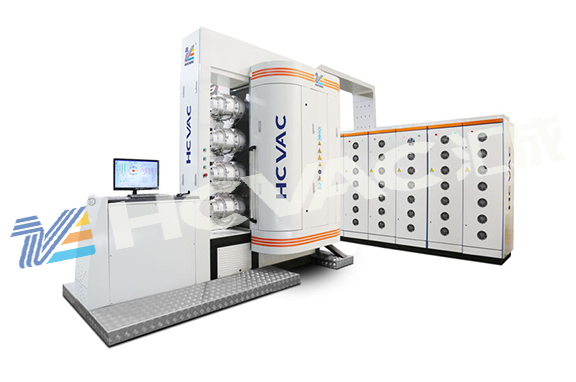With the advancement of the times and the quality of life, coating technology has grown rapidly, and various types of
pvd coating machines have begun to appear. But when it comes to the uniformity of the film, I am afraid that the uniformity of the film plated by all vacuum equipment will be affected by certain factors. Now let's take a look at the sputter-controlled sputtering coating machine to see what factors cause unevenness.
In this regard, pvd coating machine manufacturers pointed out that its operating principle is actually very simple. It uses an orthogonal magnetic field in a vacuum state to bombard the argon gas with electrons to form argon ions, which then bombard the target. The target ions are deposited on the surface of the workpiece to form a film. In this way, car lamp coating machine manufacturers should consider three aspects related to the uniformity of film thickness: vacuum state, magnetic field, and argon gas. The vacuum state needs to be controlled by the air extraction system. Each air extraction port must be opened at the same time and with the same intensity, so that the uniformity of air extraction can be controlled. If the air extraction is uneven, the pressure in the vacuum chamber will not be uniform. Pressure has a certain influence on the movement of ions. In addition, the pumping time must also be controlled. If it is too short, the vacuum will be insufficient, but if it is too long, it will waste resources. However, with the existence of a vacuum machine, it is not a problem to control it well.

(1) Environmental requirements of vacuum coating.
Cleaning the surface of the substrate (substrate) in the vacuum coating process is very important. Before the substrate enters the coating chamber, careful pre-plating cleaning should be carried out to achieve the purpose of degreasing, decontaminating and dehydrating the workpiece.
Substrate surface contamination comes from various dusts, lubricating oils, machine oils, polishing pastes, greases, sweat stains and other substances adhered to parts during processing, transportation, and packaging; oxide films generated on the surface of parts in humid air; absorption and Adsorbed gas. Vacuum coating manufacturers can basically use degreasing or chemical cleaning methods to remove these contaminants.
Clean surfaces that have been cleaned cannot be stored in an atmospheric environment. They must be stored in closed containers or cleaning cabinets to reduce dust contamination. Storage of glass substrates in freshly oxidized aluminum containers minimizes the adsorption of hydrocarbon vapors. Because these containers preferentially adsorb hydrocarbons. For highly unstable surfaces that are sensitive to water vapor, they should generally be stored in a vacuum drying oven.
Clearing the dust in the coating room, setting up a high-cleanliness workshop, and maintaining a high degree of indoor cleanliness are the basic environmental requirements of the coating process. In areas with high air humidity, in addition to carefully cleaning the substrate and components in the vacuum chamber before plating, baking and degassing are also required. To prevent oil from being brought into the vacuum chamber, pay attention to the return of oil from the oil diffusion pump. Oil-blocking measures must be taken for diffusion pumps with high heating power.
(2) Basic principles of coating and coating
A. Raw materials and basic principles:
The raw materials are resin, polymer, Teflon, silicone, acrylic acid, silicate, etc. The excipients, formulas and measurements are different. For example, if the added emulsifier is mixed in different amounts, the emulsified state will be different. Watery, milky, and pasty can all be achieved. After these substances are emulsified and demulsified, they partially penetrate or form a film.
B. Their characteristics and differences:
Coating: good penetration performance (depending on the particle size of the raw material), better surface smoothness, suitable for European and American car paints with more "pores" on the paint surface, rough, heavily sprayed, hard paint itself and need to increase the brightness It is more suitable for the face.
Coating: The coating product adds film-forming aids and curing agents, and the vacuum coating manufacturer makes it form a film instantly, and the properties change accordingly. For example, the hardness is higher than the sealing glaze, so it is more suitable for paint surfaces that need to increase the hardness of the paint surface (such as Japanese and Korean car series).
Special note: In terms of the function of filtering and reflecting ultraviolet rays, the G-resistant coating is better than the coating. Because it does not need to add ingredients such as film-forming additives and curing agents, the more pure quartz glass molecular covering layer + fusion layer has stronger dual filtering and ultraviolet reflection capabilities. What is worth worrying about is that inferior coating products use non-environmentally friendly film-forming additives, which may even cause secondary chemical damage to the paint surface.
The main performance of the protective layer:
①Prevent the oxidation and fading of original car paint: block ultraviolet rays and minimize the transmission damage of ultraviolet rays.
② Increase the brightness of the paint surface: The crystal clear glass molecules make the car paint surface radiant and dazzling.
③Improve paint surface hardness: Improve wear and scratch resistance.
④ Prevent chemical damage and extend the life of the paint: such as damage to car paint caused by alkaline car washes, acid rain and salt spray, insect sap gum, high temperature and severe cold.
⑤ Increase the smoothness of the car watch: it feels silky smooth, reduces static electricity, dust adhesion and wind resistance coefficient, making daily maintenance more convenient.
Various problems often occur during the use of
pvd coating machines. So how to deal with them and how to solve them correctly have become issues that industry practitioners need to pay attention to.



